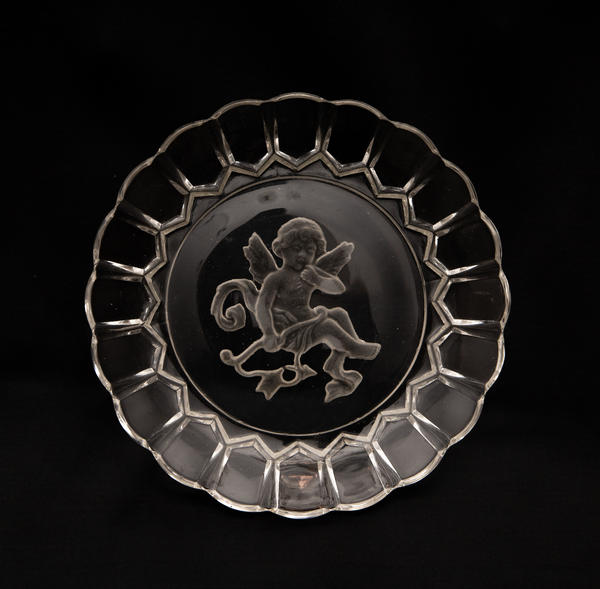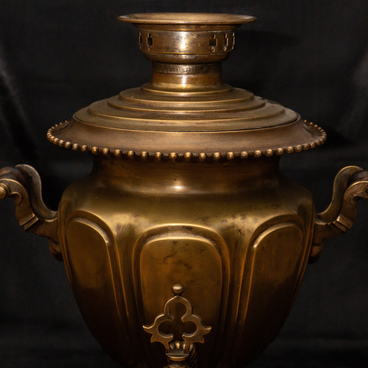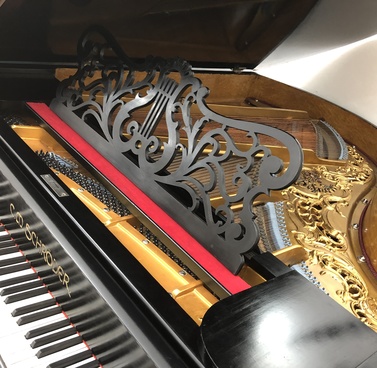This dessert plate depicting Cupid belonged to the family of Emperor Nicholas II. They made it by a custom order, specifically for Tsesarevich Alexei. Empress Alexandra Feodorovna would bring various sweets on this plate to her beloved son. Due to a serious illness, the heir to the throne was often in bed and needed such care.
The plate was made flat, with a turn-up scalloped lip. In shape, it resembled a round flower with petals. The well has a three-dimensional image of Cupid. The god of love is depicted conventionally as a winged boy with a bow and arrows. The item is made of colourless transparent crystal. The image of Cupid was engraved on the underside, thanks to which it looked three-dimensional when viewed from above. The plate was small in size and easily fitted in open palms.
Leaving for the Tobolsk exile, the Imperial Family brought a significant amount of tableware and household utensils from Tsarskoye Selo. Among them was this crystal dessert plate.
This relic entered the museum collection from the Tobolsk Museum of Fine Arts, created on the initiative of local artist and teacher Panteleymon Petrovich Chukomin in 1920. It is known that after the departure of the family of Emperor Nicholas II from Tobolsk, many things fell into townspeople’s hands. Some of them were bought at an auction, taken by servants, while other items were given by the imperial family members to ordinary townspeople as keepsakes before the departure.
When creating the museum, Panteleymon Chukomin organized an acquisition of cultural valuables not only from the State Museum Fund but also from Tobolsk residents. Thus, objects of art that belonged to the imperial family ended up in the museum. The well-known abstract artist Wassily Kandinsky, who by that time had already helped organize 22 provincial museums, was involved in the selection process.
The plate depicting Cupid entered the collection not as a memorial thing that belonged to the imperial family but as a sample of tableware that had artistic value.
The plate was made flat, with a turn-up scalloped lip. In shape, it resembled a round flower with petals. The well has a three-dimensional image of Cupid. The god of love is depicted conventionally as a winged boy with a bow and arrows. The item is made of colourless transparent crystal. The image of Cupid was engraved on the underside, thanks to which it looked three-dimensional when viewed from above. The plate was small in size and easily fitted in open palms.
Leaving for the Tobolsk exile, the Imperial Family brought a significant amount of tableware and household utensils from Tsarskoye Selo. Among them was this crystal dessert plate.
This relic entered the museum collection from the Tobolsk Museum of Fine Arts, created on the initiative of local artist and teacher Panteleymon Petrovich Chukomin in 1920. It is known that after the departure of the family of Emperor Nicholas II from Tobolsk, many things fell into townspeople’s hands. Some of them were bought at an auction, taken by servants, while other items were given by the imperial family members to ordinary townspeople as keepsakes before the departure.
When creating the museum, Panteleymon Chukomin organized an acquisition of cultural valuables not only from the State Museum Fund but also from Tobolsk residents. Thus, objects of art that belonged to the imperial family ended up in the museum. The well-known abstract artist Wassily Kandinsky, who by that time had already helped organize 22 provincial museums, was involved in the selection process.
The plate depicting Cupid entered the collection not as a memorial thing that belonged to the imperial family but as a sample of tableware that had artistic value.



